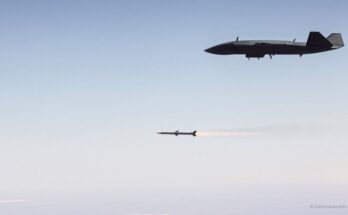by Douglas Royce, Senior Aerospace Analyst, Forecast International.
The four partner nations that developed the Eurofighter – Germany, the U.K., Spain, and Italy – ordered 472 aircraft through the end of 2018. With approximately 452 aircraft delivered by year’s end, the Eurofighter program is faced with a backlog of only 20 orders from the partners. We believe production of these aircraft will wrap up in 2020. The four partner nations are not expected to order additional aircraft, though plans may change if export orders cannot keep the line running.
Germany, for example, is considering replacing its fleet of Tornado jets with more Eurofighters. However, it is also considering the Boeing F/A-18E/F Super Hornet to fill the requirement. While buying more Eurofighters avoids the headache of maintaining separate training and maintenance pipelines for a second fighter type, the Super Hornet is well suited to the Tornado’s attack role and is significantly cheaper to acquire than the Eurofighter.
The center of the Eurofighter export market is the Middle East region, a traditional market for European combat aircraft.
Kuwait signed a $9 billion contract covering 28 aircraft in April 2016. The deal covered 22 single-seat and six dual-seat models built to the current Tranche 3 standard. Kuwait is also the launch customer for the new Captor-E AESA radar. The Kuwait Defense Ministry initially announced that two aircraft would be delivered in the fourth quarter of 2019, but recent reports indicate that Leonardo will deliver the aircraft during 2020-23.
In December 2017, Qatar finalized an order for 24 Typhoons to be built in Britain under a deal valued at GBP5 billion ($6.7 billion). Deliveries are scheduled to begin in 2022. The small Persian Gulf nation has already ordered 36 F-15s and 24 Dassault Rafale fighters. Adding yet a third type of high-end fighter makes little military sense because of the increased cost and complexity of sustainment and training, but these aircraft are bought primarily to advance a diplomatic agenda rather than as true warfighting assets.
The Kuwaiti and Qatari deals allow the Eurofighter consortium to stretch production into the mid-2020s.
In March 2018, the British government announced the signature of a new Memorandum of Understanding with Saudi Arabia covering 48 more Typhoons. The government did not say at the time when a new contract would be signed or when deliveries would begin. The diplomatic backlash to the kingdom’s killing of journalist Jamal Khashoggi in October 2018 complicates negotiations and may kill a new order entirely, and we are not yet forecasting production of the new order for the Saudi force.
Germany needs to replace its fleet of 85 Tornado jets by 2030, and expanding its fleet of Eurofighters is one option. The Typhoon will likely face off against the Lockheed Martin F-35 if the German Ministry of Defense holds a competition. The F-35 is optimized for ground attack missions and offers a level of stealth the Typhoon can’t match, and it may have an edge for the German contract.
Elsewhere, Eurofighter’s biggest problem at this stage of the program is that the potential market for new heavy twin-engine fighters is limited mostly to a few Persian Gulf states and wealthy Asian nations, many of which have already contracted for advanced fighters and are now out of the market. Each new sale makes securing the next one harder.
Sales efforts will also be complicated by an expected surge of used Eurofighters onto the secondhand market as partner nations reduce their fighter fleets. For example, the U.K. is planning to retire at least a portion of its Tranche 1 fighters in coming years. These air superiority fighters will be available on the used market, potentially competing with sales of new Typhoons.
For 50 years, Forecast International intelligence reports have been the aerospace and defense industry standard for accurate research, analysis, and projections. Our experienced analysts compile, evaluate, and present accurate data for decision makers. FI's market research reports offer concise analysis of individual programs and identify market opportunities. Each report includes a program overview, detailed statistics, recent developments and a competitive analysis, culminating in production forecasts spanning 10 or 15 years. Let our market intelligence reports be a key part of reducing uncertainties and mastering your specific market and its growth potential. Find out more at www.forecastinternational.com




